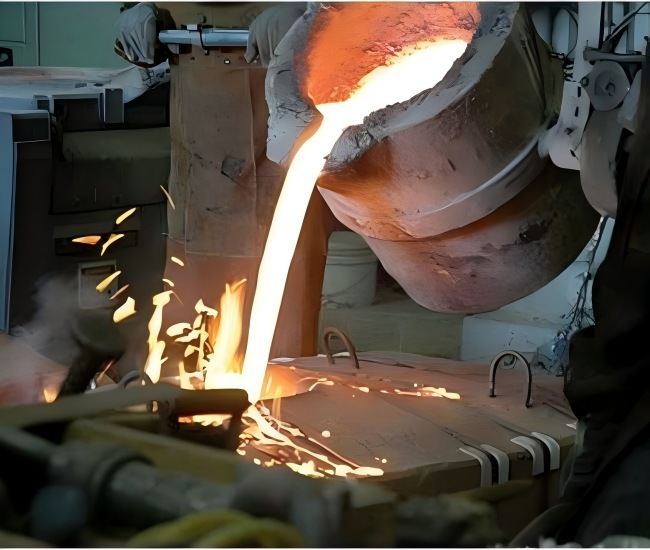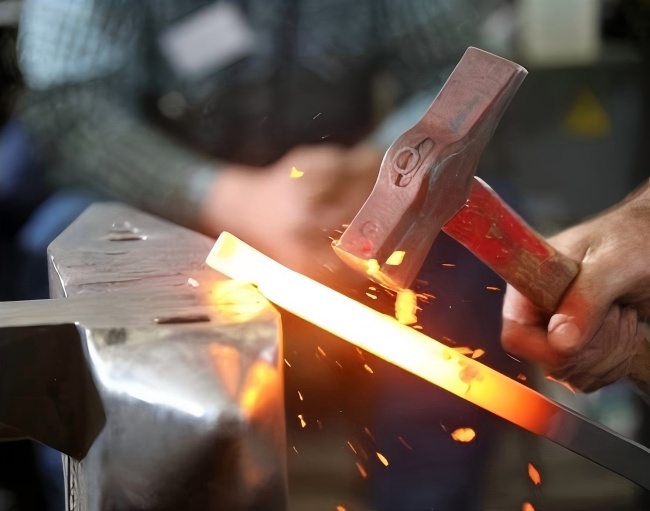Choosing the right manufacturing process can greatly impact your product’s success. A common question is: casting or forging?
This article guides you through the key differences between these two essential metal forming methods. To assist you choose the best option for your manufacturing needs, we’ll go over pricing, material fit, performance, and real-world examples.
Overview of Casting and Forging
What Is Casting?

Melting a metal, then pouring it into a mold to solidify into the required shape, is the process of casting. One of the earliest methods of manufacturing, it works well for creating intricate and complicated pieces.
Popular Casting Methods Include:
- Sand Casting: Low-cost, versatile, and ideal for large parts
- Die Casting: High precision and repeatability for large batches
- Investment Casting: Excellent surface finish and detail resolution
- Centrifugal Casting: Used for cylindrical shapes like pipes
What Is Forging?

Forging reshapes solid metal through compressive force, typically applied by hammers, dies, or presses. It enhances the strength and integrity of the material through grain refinement.
Common Forging Types:
- Open-Die Forging: Used for large, simple shapes
- Closed-Die Forging: Ideal for precision and higher volume
- Cold Forging: Excellent surface finish, requires ductile metals
- Hot Forging: Suitable for high-strength applications
| Criteria | Casting | Forging |
| Process | Pouring molten metal into a mold | Deforming solid metal using force |
| Temperature | Above melting point | Cold, warm, or hot (below melting point) |
| Complexity of Shapes | High (complex cavities, contours) | Low to moderate |
| Mold Requirement | Yes | Dies or anvils |
| Grain Flow | Random (can be improved with heat treatment) | Directional (better strength) |
| Surface Finish | Ranges from rough to smooth | Generally smoother |
Performance Metrics and Mechanical Properties
Forging outperforms casting in most mechanical metrics due to its ability to align the grain structure. Casting, however, enables greater geometric complexity.
| Property | Casting | Forging |
| Tensile Strength | Moderate | High |
| Impact Resistance | Lower | High |
| Fatigue Resistance | Medium to low | Excellent |
| Porosity Risk | Moderate to high (gas, shrinkage) | Low |
| Machinability | Good (especially in soft alloys) | May require more tooling effort |
Design Considerations
Geometry and Tolerances
- Casting allows for complex shapes, internal voids, and near-net shapes.
- Forging is better suited for parts requiring uniformity and high loads, such as axles or gears.
| Aspect | Casting | Forging |
| Wall Thickness | Variable; thin walls possible | Consistent, limited by flow characteristics |
| Dimensional Tolerance | Moderate to tight (investment/die casting) | Very tight (especially closed-die) |
| Internal Features | Yes (with cores or investment methods) | No |
| Weight Optimization | High, but can lead to lower strength | Optimized for performance |
Cost Analysis
Your budget will strongly influence your process choice. Here’s how they compare:
Upfront Costs
- Casting typically requires lower initial tooling investment, especially with sand casting.
- Forging, especially closed-die, involves significant tooling costs.
Production Costs
| Cost Factor | Casting | Forging |
| Tooling (Initial) | Low to Medium | High |
| Material Efficiency | High | Medium (flash, trimming required) |
| Per-Unit Cost (Low Volume) | Moderate to High | High |
| Per-Unit Cost (High Volume) | Low | Moderate |
| Machining/Post-processing | Often required | Minimal in near-net shape forgings |
Material Selection and Suitability
The type of metal influences whether casting or forging is more practical.
| Material | Preferred Process | Reason |
| Aluminum Alloys | Casting | Lightweight, excellent castability |
| Carbon Steel | Forging | Strong, ductile, excellent grain refinement |
| Stainless Steel | Forging | Superior durability and resistance to corrosion |
| Cast Iron | Casting | Too brittle to forge, flows easily when molten |
| Brass/Bronze | Casting | Good aesthetic and corrosion resistance |
| Titanium | Forging | High-performance aerospace and medical uses |
Applications Across Industries
Both methods serve critical roles across sectors, but use depends on specific demands.
Casting Applications
- Automotive: Engine blocks, pump housings, turbochargers
- Construction: Pipe fittings, architectural components
- Aerospace: Structural brackets, housings (non-load bearing)
- Consumer Products: Cookware, faucets, decorative items
Forging Applications
- Aerospace: Landing gear, turbine discs
- Automotive: Crankshafts, connecting rods, gears
- Oil & Gas: Drill bits, flanges, high-pressure valves
- Heavy Equipment: Axles, shafts, lifting hooks
Lead Time and Flexibility
Lead times vary significantly based on the process:
| Aspect | Casting | Forging |
| Prototype Lead Time | Fast with sand or 3D-printed molds | Slower (custom dies take time) |
| Design Changes | Easier: retooling molds is simpler | Costly: new dies may be needed |
| High-Volume Production | Very efficient | Effective once dies are established |
Environmental and Sustainability Factors
Casting may use more energy upfront (due to melting), while forging is more material efficient.
| Sustainability Factor | Casting | Forging |
| Energy Usage | High (melting furnace) | Moderate to high (mechanical presses) |
| Material Waste | Low (near-net shapes) | Moderate (trimming and flash) |
| Recyclability | Excellent (molten re-casting) | Excellent (scrap reused) |
| Pollution Risk | Emissions from binders, fluxes | Lower, but noise and vibration concerns |
Real-World Case Studies
Case Study 1: Automotive Gearbox Housing
- Challenge: Lightweight yet complex geometry with integrated channels
- Solution: Aluminum die casting
- Result: Reduced machining, good dimensional accuracy, mass production cost advantage
Case Study 2: Aircraft Landing Gear
- Challenge: High fatigue resistance and load-bearing capacity
- Solution: Forged titanium with post heat treatment
- Result: High strength-to-weight ratio, safety assurance
Case Study 3: Hand Tools
- Challenge: Impact resistance and durability
- Solution: Forged carbon steel heads
- Result: Better toughness and lifecycle compared to cast equivalents
Hybrid Approaches and Emerging Technology
With advances in engineering, hybrid solutions are being explored:
- Cast-Forge Hybrid: Casting the rough shape, then forging critical areas
- Additive-Casting Combo: 3D printing sand molds for investment casting
- Forging Die Simulation: Using software like DEFORM or QForm to optimize grain flow
- Smart Casting Monitoring: AI-integrated systems to detect defects in real time
These technologies reduce waste, increase performance, and improve turnaround time.
Decision-Making Guide
Use this quick checklist to determine the best process:
| Decision Factor | Recommendation |
| Complex internal geometry | Casting |
| High strength required | Forging |
| Low-volume production | Casting (Sand/Investment) |
| Large-volume production | Die Casting or Closed-Die Forging |
| Design flexibility needed | Casting |
| Fatigue resistance needed | Forging |
| Budget-limited prototyping | Casting (Sand) |
Conclusion
Casting and forging are not rivals—they’re tools. Which one is best depending on the requirements of your project.
By analyzing geometry, material, mechanical requirements, volume, and budget, you can confidently select the process that aligns with your production goals.
